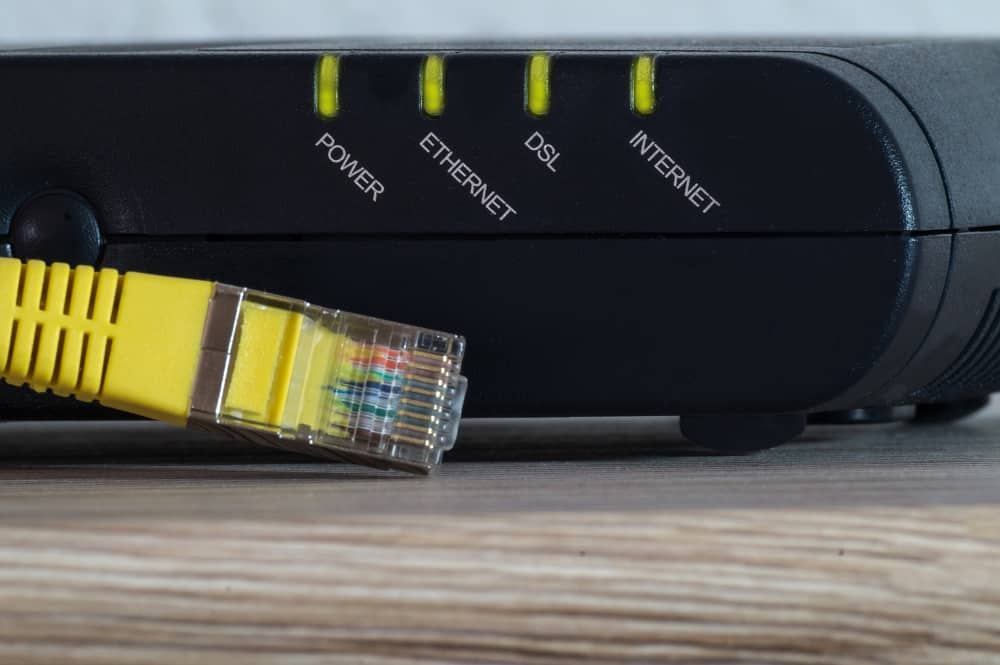Broadband has come to mean an always on, high speed, high capacity / wide bandwidth access to the Internet. Broadband access can be achieved over a number of connection media, such as coaxial cable, satellite, wireless, copper wire, and fiber optic cable.
Almost all Internet subscriber connections today are implemented over a broadband connection.
Ethernet on the other hand, refers to a physical, wired connection, and low level packet protocol framework that interconnects network devices.
Almost anyone who has used a wired connection on a network, will know of Ethernet cables that connect Personal Computers (and other devices) to a Local Area Network (LAN), usually via a network switch of some type.
Broadband
Broadband generally refers to wide bandwidth data transmission. However, with almost all forms of communication and online services having taken the route of the Internet, it has become synonymous with high bit-rate Internet access.
According to the FCC, broadband refers to high-speed Internet access that is always on and faster than traditional dial-up access. The types of broadband Internet connections available, include Digital Subscriber Line (DSL), cable, fiber, wireless, and satellite.
DSL and cable are the most common form of broadband connection in the U.S. and UK for households, and fiber optic for large businesses. DSL uses the existing telephone copper cables already in place, while cable uses the coaxial cables used to deliver cable TV.
Ethernet

While most of us tend to think of Ethernet as only referring to the physical medium used in network connections, it also encompasses a low-level transmission protocol for data over that medium, that also includes error detection (but not error correction).
We’ll be taking a look at Ethernet cabling media and the protocol, before discussing what role it plays in broadband, and specifically, broadband internet access.
Ethernet network cables are classified according to their category, which is based on the bandwidth frequency the cable can handle, the maximum data rate supported, and whether the cable is shielded or unshielded.
Typical Ethernet LAN connection speeds of 10Mbps, 100Mbps, and 1Gbps, use Category 5 and Category 5e (more commonly referred to as Cat5 and Cat5e respectively) and Unshielded Twisted Pair (UTP) cables.
While Cat5 and Cat5e Ethernet cables are the most common, Cat6 (and specifically Cat6a) are now coming into more use as data transmission speeds begin to go well into the gigabit range.
An Ethernet, UTP cable, has four, unshielded twisted pairs of solid copper wires, terminated with RJ-45 connectors.
Ordinarily, with other types of telecommunications and network cables, shielding is used in order to cut down on noise and crosstalk from neighboring cables. With Ethernet Cat5 and Cat6 cables for speeds up to 1Gbps, this is achieved by sufficient twisting of each pair of wires.
Not having to shield the cables also helps keep the cost down, which is why this type of cable is so popular.
One limitation of Ethernet cables is that they cannot be used over long runs. The specifications for Cat5 and Cat5e cables, stipulate a maximum distance of 328 ft (100 meters) for error free operation at data rates up to 1Gbps.
Cat6a, also has a maximum range of 328 ft, but can handle data rates up to 10Gbps.
Going over the 328 ft maximum range does not mean that the connection will no longer work, but depending on the quality of the cable, the signal will start to degrade as the run gets further away from the source.
There are two measurements used to gauge the quality of a connection, Signal to Noise Ratio (SNR), and attenuation. Attenuation is a weakening of the signal as it travels further away from its source, while SNR indicates how strong the signal is compared to any noise on the line.
While we’ve dealt with the physical aspect of Ethernet, we also need to take a very quick and brief look at how data is transmitted over the medium, so as to understand how it fits in with broadband Internet.
At the lowest level, data sent over Ethernet is broken down and reconstructed into small packets called frames. Each frame contains the source and destination addresses, and includes a frame check sequence (FCS) used for error detection.
While any frames with errors are discarded, it is up to higher level protocols (typically at the Transport Layer in the Open Systems Interconnection model (OSI model)), to request the retransmission of lost frames.
Rounding Up
While many ISPs are slowly converting their subscriber connections to fiber optic cable which will give subscribers gigabit Internet access, fiber optic cable is still an expensive medium, plus it will take some time to replace the copper wire cabling already in place.
Recent developments in Very high-speed Digital Subscriber Line (VDSL) technology have allowed providers to offer 100Mbps and higher, over the existing copper wire infrastructure.
VDSL2 and Super VDSL (also referred to as VDSL2-Vplus), can offer 150Mbps and 300Mbps respectively, on short loop runs up to 1000 ft (~300 meters).
Providers will usually install in neighborhoods, a Fiber to the curb (FTTC) cabinet, with a fiber optic cable connection from the data center, and then use the existing copper lines to provide a VDSL connection between the cabinet and the subscriber’s premises.
This type of run from the cabinet to the subscriber, is commonly referred to as Ethernet in the First Mile (EFM), and is covered by the IEEE 802.3ah standard. As long as the distance from the subscriber to the cabinet is inside the 1000 ft range, very high speed broadband connections can be offered.
So what does all this have to do with Ethernet? Well, remember we mentioned earlier that Ethernet is not just a cable specification, but also includes a data transmission protocol that breaks the transmitted data into small frames.
The Ethernet low level protocol is not only used over a LAN, or connection between a PC (or any other equipment connected via an Ethernet cable) and the Internet modem, it is also used on fiber optic networks, as well as broadband Internet over VDSL connections to customer premises (hence the term Ethernet in the First Mile).

